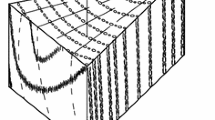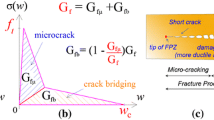Abstract
Specific fracture energy measurements were applied to identify changes caused by wood-drying processes of solid wood. Specimen design and geometry as well as parameters and specifications for a fracture energy test were determined experimentally. The specific test set-up was applied on plantation teakwood sample sets of standard as well as alternating convection kiln dryings and one oven drying. The results show that alternating changes of the drying temperature along with the equilibrium moisture content (EMC) in a kiln schedule have a small but significant decreasing effect on the specific fracture energy in the radial/longitudinal as well as the tangential/longitudinal testing direction. Furthermore, oven drying at constant high drying temperature along with low EMC did not result in a significant change of specific fracture energy compared with standard drying, but caused greater scattering values in both transverse crack propagation systems.





Similar content being viewed by others
References
ASTM D 3433-75 (1985) Standard practice for fracture strength in cleavage of adhesives in bonded joints. American Society for Testing and Materials, Philadelphia
Bhat MK, Priya BP, Rugmini P (2001) Characterisation of juvenile wood in teak. Wood Sci Technol 34:517–532
Burmester A (1975) Zur Dimensionsstabilisierung von Holz. Holz Roh-Werkst 33:333–335
Ehart AJR, Stanzl-Tschegg SE, Tschegg EK (1996) Characterization of crack propagation in particleboard. Wood Sci Technol 30:307–321
EN 14298 (2004) Sawn timber—assessment of drying quality. European Standard, Brussels
Frühmann K, Tschegg EK, Dai C, Stanzl-Tschegg SE (2002) Fracture behaviour of laminated veneer lumber under mode I and III loading. Wood Sci Technol 36:319–334
Gerhards CC (1986) High-temperature drying of southern pine 2 by 4's: effects on strength and load duration in bending. Wood Sci Technol 20:349–360
Griffith AA (1921) The Phenomena of Rupture and Flow in Solids. Philos Trans R Soc Lond A 221:163–198
Hillis WE (1984) High temperature and chemical effects on wood stability. Part 1: general considerations. Wood Sci Technol 18:281–293
Hinterstoisser B, Weingärtner J, Praznik W (1992) Influence of wood drying processes on the carbohydrate matrix of wood of picea abies. In: Proceedings of 3rd IUFRO International Conference. Vienna, pp 217–221
Irwin RG (1958) Fracture. Encyclopedia of Physics, Berlin
Kifetew G, Thuvander F, Berglund L, Lindberg H (1998) The effect of drying on wood fracture surfaces form specimens loaded in wet condition. Wood Sci Technol 32:83–94
Logemann M, Schelling W (1992) Die Bruchzähigkeit von Fichte und ihre wesentlichen Einflußparameter—Untersuchung im mode-1. Holz Roh-Werkst 20:47–52
Mai YW (1975) On the velocity-dependent fracture toughness of wood. Wood Sci 8(1):364–367
Majano–Majano A, Hughes M, Fernandez-Cabo JL (2012) The fracture toughness and properties of thermally modified beech and ash at different moisture contents. Wood Sci Technol 46:5–21
Oltean L, Teischinger A, Hansmann C (2007) Influence of temperature on cracking and mechanical properties of wood during wood drying—a review. Bioresources 2(4):789–811
Oltean L, Teischinger A, Hansmann C (2011) Influence of low and moderate temperature kiln drying schedules on specific mechanical properties of Norway spruce wood. Eur J Wood Wood Prod 69(3):451–457
Perré P (2007) Fundamentals of wood drying. COST, A.R.BO.LOR, European COST, France
Pleschberger H, Teischinger A, Müller U, Hansmann C (2013) Mechanical characterization of lumber of small-diameter hardwood species after different drying schedules. Dry Technol 31(9):1056–1062
Porter AW (1964) On the mechanics of fracture in wood. For Prod J 14(2):325–331
Posch B, Wegener G, Grosser D, Wagner L (2004) Physikalische und mechanische Untersuchungen an Teakholz (Tectona grandis L.f.) aus Plantagen in Panamá. Holz Roh-Werkst 62:31–35
Reiterer A (2001) The influence of temperature on the mode I fracture behaviour of wood. J Mater Sci 20:1905–1907
Schniewind AP, Ohgama T, Aoki T, Yamada T (1982) Effect of specific gravity, moisture content, and temperature on fracture toughness of wood. Wood Sci 15(2):101–109
Smith I, Chui YH (1994) Factors affecting mode I fracture energy of plantation-grown red pine. Wood Sci Technol 28:147–157
Smith I, Landis E, Gong M (2003) Fracture and fatigue in wood. Wiley, Chichester
Stanzl-Tschegg SE (2006) Microstructure and fracture mechanical response of wood. Int J Fracture 139:495–508
Stanzl-Tschegg SE, Tschegg E, Teischinger A (1994) Fracture energy of spruce wood after different drying procedures. Wood Fiber Sci 24(4):467–478
Stanzl-Tschegg SE, Tan MD, Teschegg EK (1995) New splitting method for wood fracture characterization. Wood Sci Technol 29:31–55
Teischinger A (1992) Effect of different drying temperatures on selected physical wood properties. In: Proceedings of 3rd IUFRO International Conference. Vienna, pp 211–216
Tschegg EK, Frühmann K, Stanzl-Tschegg ES (2001) Damage and fracture mechanisms during mode I and III loading of wood. Holzforschung 55:525–533
Welling J (1996) Zur Ermittlung der Trocknungsqualität von Schnittholz. Holz Roh-Werkst 54:307–311
Author information
Authors and Affiliations
Corresponding author
Rights and permissions
About this article
Cite this article
Pleschberger, H., Hansmann, C., Müller, U. et al. Fracture energy approach for the identification of changes in the wood caused by the drying processes. Wood Sci Technol 47, 1323–1334 (2013). https://doi.org/10.1007/s00226-013-0578-z
Received:
Published:
Issue Date:
DOI: https://doi.org/10.1007/s00226-013-0578-z




